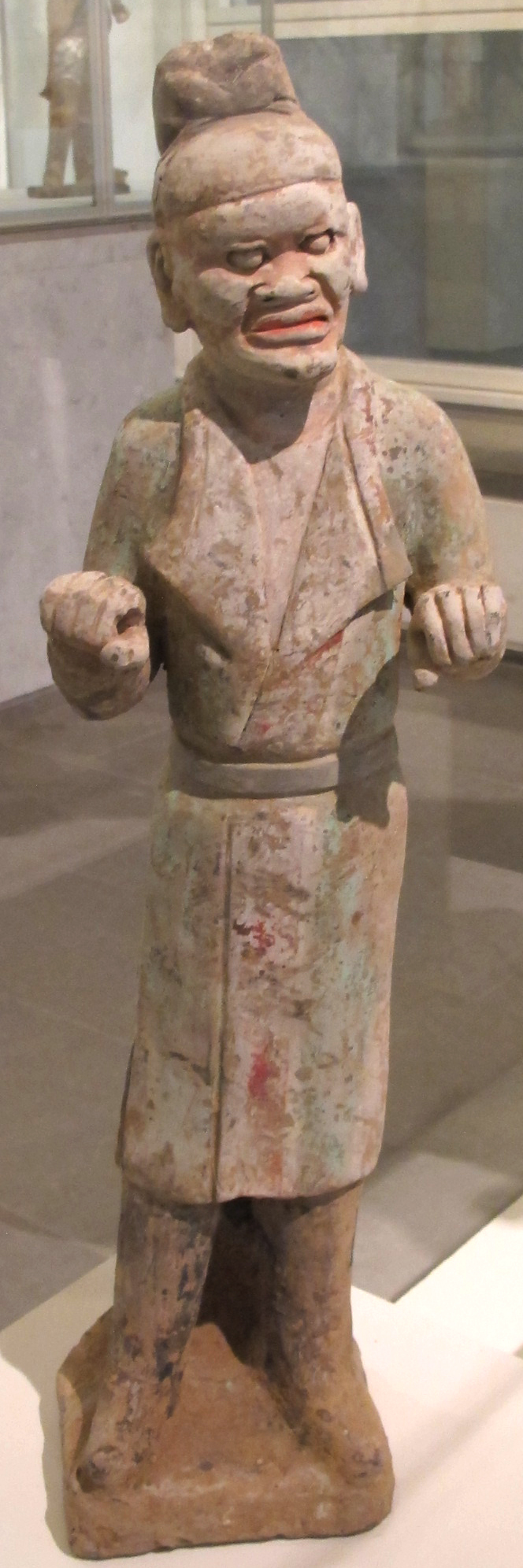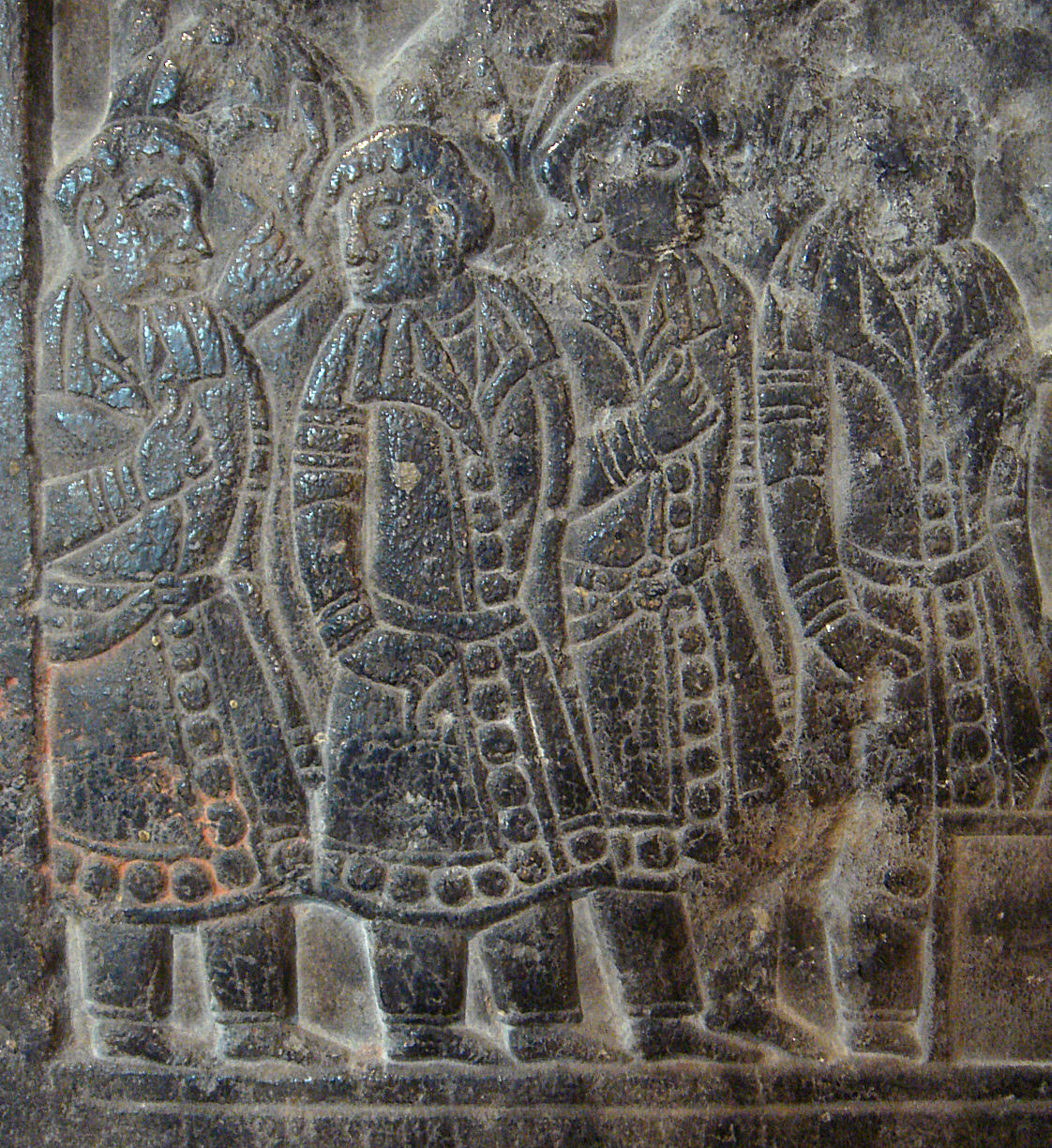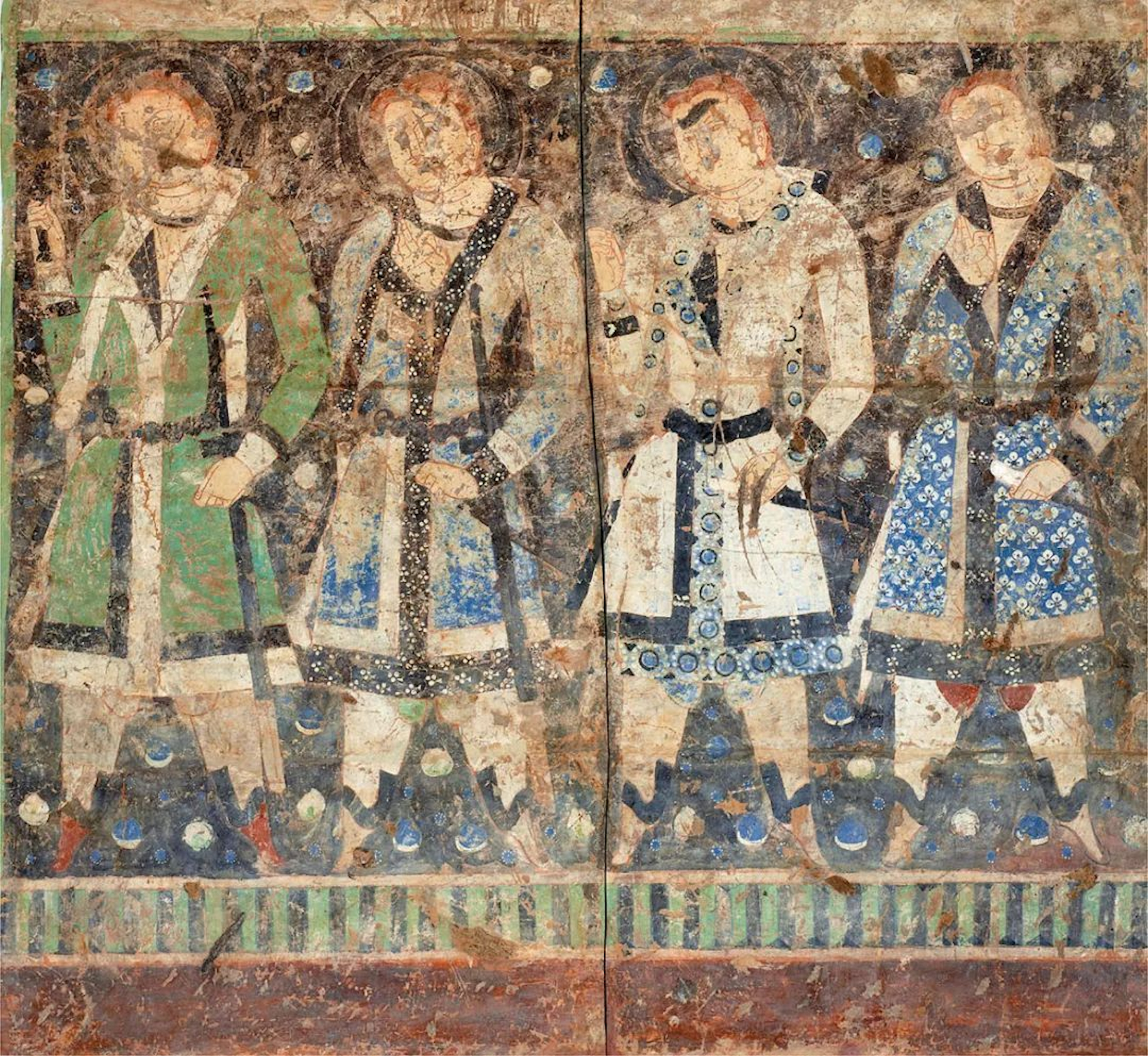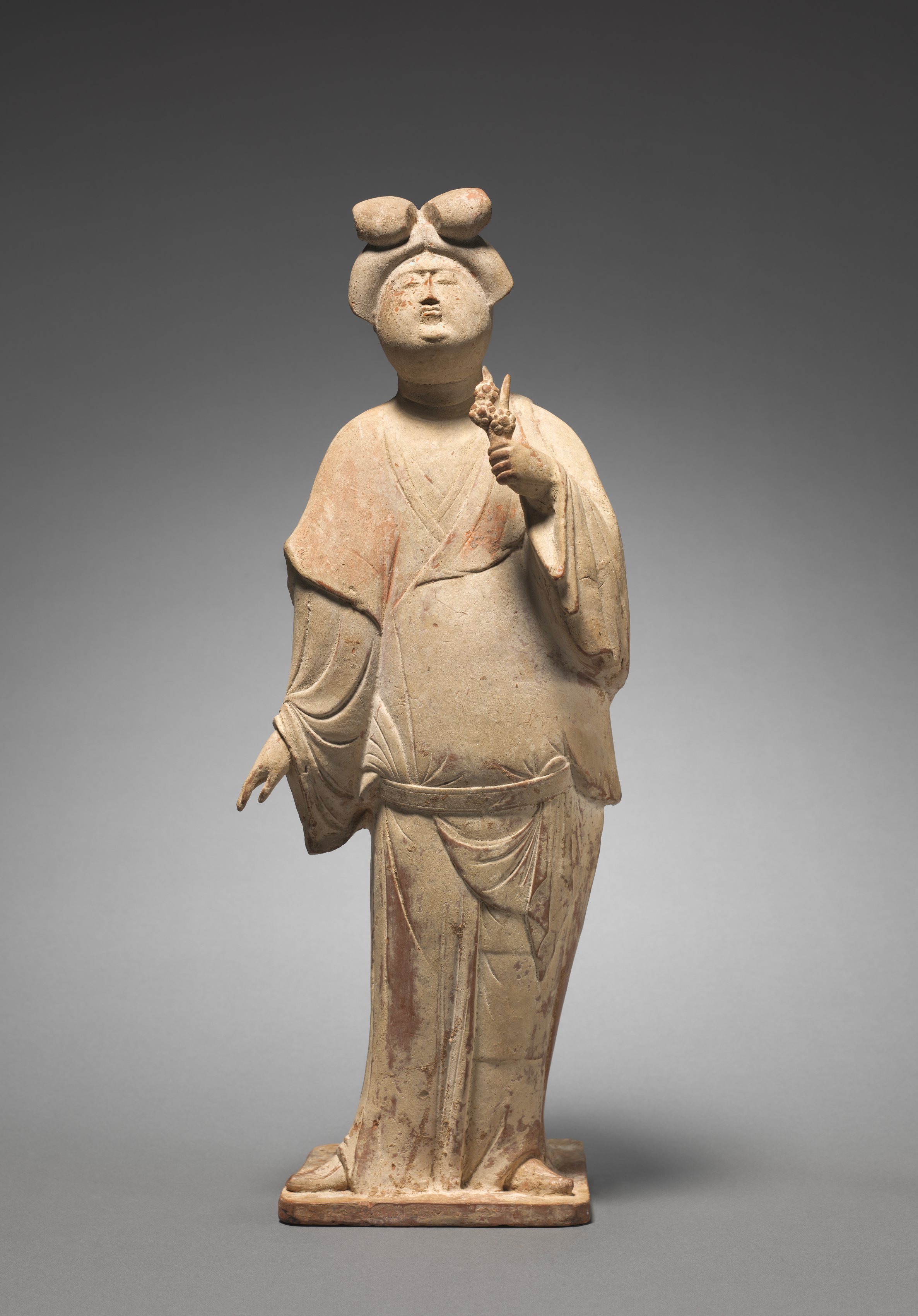Fanlingpao on:
[Wikipedia]
[Google]
[Amazon]
Fanlingpao (), sometimes referred as kuapao () and hufu (
 Double-overturned lapel
Double-overturned lapel
 Lapels robes originated from
Lapels robes originated from  The
The  Under the influence and the demands of the Chinese population, as well as Chinese traditions, most Sogdian attire in China had to be closed to the right. Their robes were versatile, it could often be transformed into a yuanlingpao-like robe by buttoning up the neck to form the round collar or occasionally have their lower button undone allowing their collars to be form lapels, becoming lapel robes. The Sogdians in China and Sogdia had both lapels down following the Iranian tradition or the tradition of the
Under the influence and the demands of the Chinese population, as well as Chinese traditions, most Sogdian attire in China had to be closed to the right. Their robes were versatile, it could often be transformed into a yuanlingpao-like robe by buttoning up the neck to form the round collar or occasionally have their lower button undone allowing their collars to be form lapels, becoming lapel robes. The Sogdians in China and Sogdia had both lapels down following the Iranian tradition or the tradition of the
 Fanlingpao worn during the
Fanlingpao worn during the  From the 7th to the 8th century, the kuapao and fanlingpao-like robes were popular; it was especially popular during the Wuzetian period (684 ŌĆō704 AD). The fanlingpao of the preceding dynasties were further developed in the Tang dynasty; such that it could be transformed into the yuanlingpao by buttoning up three buttons on the collar. It overlaps and closed to the right side, which follows the traditional Han Chinese system. While adopting certain elements from foreign dress (e.g. Sogdian and Turk lapel robes), the Chinese however maintain their traditional way of closing their fanglingpao on the right side. The kuapao was also worn by women, who would wear it to cross-dress as men. It could be used as a jacket and was thrown over the shoulders like a
From the 7th to the 8th century, the kuapao and fanlingpao-like robes were popular; it was especially popular during the Wuzetian period (684 ŌĆō704 AD). The fanlingpao of the preceding dynasties were further developed in the Tang dynasty; such that it could be transformed into the yuanlingpao by buttoning up three buttons on the collar. It overlaps and closed to the right side, which follows the traditional Han Chinese system. While adopting certain elements from foreign dress (e.g. Sogdian and Turk lapel robes), the Chinese however maintain their traditional way of closing their fanglingpao on the right side. The kuapao was also worn by women, who would wear it to cross-dress as men. It could be used as a jacket and was thrown over the shoulders like a
File:Sui Painted Pottery Attendant 01.jpg, Attendant wearing lapel robe (right overlap and closes at the front), Sui dynasty
File:Dinastia tang, tre falconieri, cina del nord, VIII sec.JPG, ''
Kuapao
' {{Types of Han Chinese clothing Chinese traditional clothing Tang dynasty culture
Chinese
Chinese can refer to:
* Something related to China
* Chinese people, people of Chinese nationality, citizenship, and/or ethnicity
**''Zhonghua minzu'', the supra-ethnic concept of the Chinese nation
** List of ethnic groups in China, people of va ...
: ĶāĪµ£Ź) in the Tang dynasty
The Tang dynasty (, ; zh, t= ), or Tang Empire, was an Dynasties in Chinese history, imperial dynasty of China that ruled from 618 to 907 AD, with an Zhou dynasty (690ŌĆō705), interregnum between 690 and 705. It was preceded by the Sui dyn ...
when they feature double overturned lapels, is a type of paofu
(), also known as () for short, is a form of a long, one-piece robe in , which is characterized by the natural integration of the upper and lower part of the robe which is cut from a single fabric. The term is often used to refer to the and the ...
with lapels
Lapels ( ) are the folded flaps of cloth on the front of a jacket or coat below the collar and are most commonly found on formal clothing and suit jackets. Usually they are formed by folding over the front edges of the jacket or coat and sewin ...
. It was categorized as Hufu instead of Hanfu
''Hanfu'' () is the traditional styles of clothing worn by the Han Chinese. There are several representative styles of ''hanfu'', such as the (an upper-body garment with a long outer skirt), the (an upper-body garment with a long underskirt ...
due to its association with clothing of the foreigners who came from the Silk road
The Silk Road () was a network of Eurasian trade routes active from the second century BCE until the mid-15th century. Spanning over 6,400 kilometers (4,000 miles), it played a central role in facilitating economic, cultural, political, and reli ...
. Fanlingpao were first introduced in China
China, officially the People's Republic of China (PRC), is a country in East Asia. It is the world's most populous country, with a population exceeding 1.4 billion, slightly ahead of India. China spans the equivalent of five time zones and ...
during the Northern Wei dynasty
Wei (), known in historiography as the Northern Wei (), Tuoba Wei (), Yuan Wei () and Later Wei (), was founded by the Tuoba (Tabgach) clan of the Xianbei. The first of the Northern dynasties, it ruled northern China from 386 to 535 during the ...
and became popular in Northern Qi
Qi, known as the Northern Qi (), Later Qi (ÕŠīķĮŖ) or Gao Qi (ķ½śķĮŖ) in historiography, was a Chinese imperial dynasty and one of the Northern dynasties during the Northern and Southern dynasties era. It ruled the eastern part of northern China ...
. The custom of wearing fanlingpao were then inherited and further developed in the Sui and Tang dynasties. The fanlingpao could be transformed into a round collar robe
Round collar robe, also called () and in China, (; ; ) in Korea, was a style of , a Chinese robe, worn in ancient China, which was long enough to cover the entire body of its wearer. The Chinese was developed under the influences of the wo ...
, called yuanlingpao, in the Tang dynasty through the use of buttons. The fanlingpao shows foreign influences, which are mostly likely from the Persian
Persian may refer to:
* People and things from Iran, historically called ''Persia'' in the English language
** Persians, the majority ethnic group in Iran, not to be conflated with the Iranic peoples
** Persian language, an Iranian language of the ...
, Sassanian Persian, Iranian Sogdian, and Turkic. Fanlingpao were popular fashion during Tang dynasty for both men and women and showed the popularity of Hufu-style clothing during this period; it was considered hufu while yuanlingpao was categorized as a form Hanfu
''Hanfu'' () is the traditional styles of clothing worn by the Han Chinese. There are several representative styles of ''hanfu'', such as the (an upper-body garment with a long outer skirt), the (an upper-body garment with a long underskirt ...
.
Terminology
kaftan
A kaftan or caftan (; fa, ž«┘üž¬ž¦┘å, ) is a variant of the robe or tunic. Originating in Asia, it has been worn by a number of cultures around the world for thousands of years. In Russian usage, ''kaftan'' instead refers to a style of men's l ...
-like robe were called kuapao and were referred as hufu in the Tang dynasty
The Tang dynasty (, ; zh, t= ), or Tang Empire, was an Dynasties in Chinese history, imperial dynasty of China that ruled from 618 to 907 AD, with an Zhou dynasty (690ŌĆō705), interregnum between 690 and 705. It was preceded by the Sui dyn ...
; kuapao was characterized with tight sleeves and double overturned lapels with short overlap which closes at the front in proximity to the centre of the body (or with a front opening). The kuapao could also be enriched with pattern trims or border decorations at the sleeves cuffs and along the lapels. In appearance, the kuapao looks similar to the kaftan with lapels and slim sleeves used by the Persian
Persian may refer to:
* People and things from Iran, historically called ''Persia'' in the English language
** Persians, the majority ethnic group in Iran, not to be conflated with the Iranic peoples
** Persian language, an Iranian language of the ...
. This form of lapel robe originated from Central Asia
Central Asia, also known as Middle Asia, is a subregion, region of Asia that stretches from the Caspian Sea in the west to western China and Mongolia in the east, and from Afghanistan and Iran in the south to Russia in the north. It includes t ...
and was typically worn by men.
The term kuapao was sometimes used to refer to double over-turned fanlingpao with tight sleeves, which overlaps at the front and closes on the right side of the body near the armpit in the Tang dynasty. This form of overlapping closure to the right is a traditional Han Chinese
The Han Chinese () or Han people (), are an East Asian ethnic group native to China. They constitute the world's largest ethnic group, making up about 18% of the global population and consisting of various subgroups speaking distinctive va ...
characteristic, which was sometimes adopted by foreigners and/or non-Han Chinese, who had borrowed Chinese elements.
History
 Lapels robes originated from
Lapels robes originated from Western Asia
Western Asia, West Asia, or Southwest Asia, is the westernmost subregion of the larger geographical region of Asia, as defined by some academics, UN bodies and other institutions. It is almost entirely a part of the Middle East, and includes Ana ...
and were popular in Central Asian
Central Asia, also known as Middle Asia, is a region of Asia that stretches from the Caspian Sea in the west to western China and Mongolia in the east, and from Afghanistan and Iran in the south to Russia in the north. It includes the former S ...
in the Sogdian region, in Qiuci
Kucha, or Kuche (also: ''Ku├¦ar'', ''Kuchar''; ug, ┘ā█ć┌垦ž▒, ąÜčāčćą░čĆ; zh, t= ķŠ£Ķī▓, p=Qi┼½c├Ł, zh, t=Õ║½Ķ╗Ŗ, p=K├╣ch─ō; sa, ÓżĢÓźéÓżÜÓźĆÓż©, translit=K┼½c─½na), was an ancient Buddhist kingdom located on the branch of the Silk Road t ...
, and Gaochang
Gaochang (; Old Uyghur: ''Qocho''), also called Khocho, Karakhoja, Qara-hoja, Kara-Khoja or Karahoja (┘鞦ž▒ž¦ž║┘łž¼ž¦ in Uyghur), was a ruined, ancient oasis city on the northern rim of the inhospitable Taklamakan Desert in present-day Xinj ...
. Lapels robes were spread eastward through the Sogdians :''This category lists articles related to historical Iranian peoples''
Historical
Peoples
Iranian
Iranian
Iranian
Iranian may refer to:
* Iran, a sovereign state
* Iranian peoples, the speakers of the Iranian languages. The term Iranic peoples ...
. Lapel robes were first introduced in the north region of China during the Northern Wei dynasty
Wei (), known in historiography as the Northern Wei (), Tuoba Wei (), Yuan Wei () and Later Wei (), was founded by the Tuoba (Tabgach) clan of the Xianbei. The first of the Northern dynasties, it ruled northern China from 386 to 535 during the ...
. The earliest depictions of Xianbei
The Xianbei (; ) were a Proto-Mongolic ancient nomadic people that once resided in the eastern Eurasian steppes in what is today Mongolia, Inner Mongolia, and Northeastern China. They originated from the Donghu people who splintered into the ...
and Han Chinese people wearing lapel robes in China also date back to the Norther Wei dynasty.
 The
The Sogdians :''This category lists articles related to historical Iranian peoples''
Historical
Peoples
Iranian
Iranian
Iranian
Iranian may refer to:
* Iran, a sovereign state
* Iranian peoples, the speakers of the Iranian languages. The term Iranic peoples ...
, who lived in China, were most influential between the second half of the 6th century and the beginning of the 7th century. The Sogdians and their descendants (mostly from the merchant class) who lived in China during this period also wore a form of knee-length, yuanlingpao-like kaftan
A kaftan or caftan (; fa, ž«┘üž¬ž¦┘å, ) is a variant of the robe or tunic. Originating in Asia, it has been worn by a number of cultures around the world for thousands of years. In Russian usage, ''kaftan'' instead refers to a style of men's l ...
that retained their own ethnic characteristics but also showed some influences from East Asia
East Asia is the eastern region of Asia, which is defined in both geographical and ethno-cultural terms. The modern states of East Asia include China, Japan, Mongolia, North Korea, South Korea, and Taiwan. China, North Korea, South Korea and ...
(i.e., Chinese and early Turks
Turk or Turks may refer to:
Communities and ethnic groups
* Turkic peoples, a collection of ethnic groups who speak Turkic languages
* Turkish people, or the Turks, a Turkic ethnic group and nation
* Turkish citizen, a citizen of the Republic o ...
).  Under the influence and the demands of the Chinese population, as well as Chinese traditions, most Sogdian attire in China had to be closed to the right. Their robes were versatile, it could often be transformed into a yuanlingpao-like robe by buttoning up the neck to form the round collar or occasionally have their lower button undone allowing their collars to be form lapels, becoming lapel robes. The Sogdians in China and Sogdia had both lapels down following the Iranian tradition or the tradition of the
Under the influence and the demands of the Chinese population, as well as Chinese traditions, most Sogdian attire in China had to be closed to the right. Their robes were versatile, it could often be transformed into a yuanlingpao-like robe by buttoning up the neck to form the round collar or occasionally have their lower button undone allowing their collars to be form lapels, becoming lapel robes. The Sogdians in China and Sogdia had both lapels down following the Iranian tradition or the tradition of the Saka people
The Saka ( Old Persian: ; Kharoß╣Żß╣Łh─½: ; Ancient Egyptian: , ; , old , mod. , ), Shaka (Sanskrit ( Br─ühm─½): , , ; Sanskrit (Devan─ügar─½): , ), or Sacae (Ancient Greek: ; Latin: ) were a group of nomadic Iranian peoples who histo ...
living in the Khotan
Hotan (also known as Gosthana, Gaustana, Godana, Godaniya, Khotan, Hetian, Hotien) is a major oasis town in southwestern Xinjiang, an autonomous region in Western China. The city proper of Hotan broke off from the larger Hotan County to become ...
Oasis. It was however not rare for Chinese Sogdians to wear their robes with only the left lapel, which was a distinguishing feature as the only left lapel robe was rarely found (almost unknown) in Sogdia
Sogdia (Sogdian language, Sogdian: ) or Sogdiana was an ancient Iranian peoples, Iranian civilization between the Amu Darya and the Syr Darya, and in present-day Uzbekistan, Turkmenistan, Tajikistan, Kazakhstan, and Kyrgyzstan. Sogdiana was also ...
. By the Northern Qi
Qi, known as the Northern Qi (), Later Qi (ÕŠīķĮŖ) or Gao Qi (ķ½śķĮŖ) in historiography, was a Chinese imperial dynasty and one of the Northern dynasties during the Northern and Southern dynasties era. It ruled the eastern part of northern China ...
dynasty, lapel robes had become popular in the Han Chinese regions and were worn by both men and women. The wearing custom lapel robes were then inherited and further developed in the Sui and Tang dynasties.
Sui and Tang dynasties
 Fanlingpao worn during the
Fanlingpao worn during the Tang dynasty
The Tang dynasty (, ; zh, t= ), or Tang Empire, was an Dynasties in Chinese history, imperial dynasty of China that ruled from 618 to 907 AD, with an Zhou dynasty (690ŌĆō705), interregnum between 690 and 705. It was preceded by the Sui dyn ...
was categorized as Hufu. Hufu was very popular in the Tang dynasty during the Kaiyuan and Tianbao era during the reign of Emperor Xuanzong. During the Tang dynasty, hufu was influenced by foreign cultures which came from the Silk road
The Silk Road () was a network of Eurasian trade routes active from the second century BCE until the mid-15th century. Spanning over 6,400 kilometers (4,000 miles), it played a central role in facilitating economic, cultural, political, and reli ...
; most likely from the Persian
Persian may refer to:
* People and things from Iran, historically called ''Persia'' in the English language
** Persians, the majority ethnic group in Iran, not to be conflated with the Iranic peoples
** Persian language, an Iranian language of the ...
, Sassanian Persian, Iranian Sogdian, and the Turkic people
The Turkic peoples are a collection of diverse ethnic groups of West Asia, West, Central Asia, Central, East Asia, East, and North Asia as well as parts of Europe, who speak Turkic languages.. "Turkic peoples, any of various peoples whose memb ...
. From the 7th to the 8th century, the kuapao and fanlingpao-like robes were popular; it was especially popular during the Wuzetian period (684 ŌĆō704 AD). The fanlingpao of the preceding dynasties were further developed in the Tang dynasty; such that it could be transformed into the yuanlingpao by buttoning up three buttons on the collar. It overlaps and closed to the right side, which follows the traditional Han Chinese system. While adopting certain elements from foreign dress (e.g. Sogdian and Turk lapel robes), the Chinese however maintain their traditional way of closing their fanglingpao on the right side. The kuapao was also worn by women, who would wear it to cross-dress as men. It could be used as a jacket and was thrown over the shoulders like a
From the 7th to the 8th century, the kuapao and fanlingpao-like robes were popular; it was especially popular during the Wuzetian period (684 ŌĆō704 AD). The fanlingpao of the preceding dynasties were further developed in the Tang dynasty; such that it could be transformed into the yuanlingpao by buttoning up three buttons on the collar. It overlaps and closed to the right side, which follows the traditional Han Chinese system. While adopting certain elements from foreign dress (e.g. Sogdian and Turk lapel robes), the Chinese however maintain their traditional way of closing their fanglingpao on the right side. The kuapao was also worn by women, who would wear it to cross-dress as men. It could be used as a jacket and was thrown over the shoulders like a cloak
A cloak is a type of loose garment worn over clothing, mostly but not always as outerwear for outdoor wear, serving the same purpose as an overcoat, protecting the wearer from the weather. It may form part of a uniform. Cloaks have been and a ...
, which made women looked more masculine. It was worn with stripped trousers and leather waist-belt with leather strip attached to the belt.
Huihuzuang
A new style of fanlingpao which was classified as a Uyghur dress was worn by the 9th century; this form of fanlingpao also had turned-down lapels, but they were also different from the previous lapel robes. It was long enough to reach the ground, voluminous, and the sleeves were slim-fitting. This form of lapel robe was referred as Huihuzhuang (Õø×ķČ╗ĶŻģ, "costumes in Uyghur style"); the Huihu were the predecessors of the Uyghur. The Huihuzhuang was produced for the women of Han ethnic and had been inspired by the robes of Huihu women. The upper part of the robe was loose and had decorative patterns (or borders) on the collar and sleeves cuffs. Based on the reconstruction from theDunhuang
Dunhuang () is a county-level city in Northwestern Gansu Province, Western China. According to the 2010 Chinese census, the city has a population of 186,027, though 2019 estimates put the city's population at about 191,800. Dunhuang was a major ...
frescoes, the Huihuzhuang had an overlapping front which could be closed with ties on the right or left side. Warm, colours were preferred, and the colour red was typically used; it was also generally made of thick brocade. The Huihuzhuang was very popular among the Tang dynasty's aristocratic women and the women of the imperial court. The rise of Uyghur-style robe occurred after the rebellion of An Lushan
An Lushan (; 20th day of the 1st month 19 February 703 ŌĆō 29 January 757) was a general in the Tang dynasty and is primarily known for instigating the An Lushan Rebellion.
An Lushan was of Sogdian and G├Čkt├╝rk origin,Yang, Zhijiu, "An Lushan ...
, when Uyghur culture grew along with their military power.
Gallery
Sancai
''Sancai'' ()Vainker, 75 is a versatile type of decoration on Chinese pottery using glazes or slip, predominantly in the three colours of brown (or amber), green, and a creamy off-white. It is particularly associated with the Tang Dynasty (618ŌĆ ...
'' figures wearing fanlingpao (kuapao-style), overlaps on the right and closes to the right, Tang dynasty.
File:Woman wearing hufu in Tang Dynasty.jpg, Tang dynasty woman wearing kuapao, a ''hufu''-style fashion.
File:Museum f├╝r Indische Kunst Dahlem Berlin Mai 2006 061.jpg, Kuapao worn as a cloak
Related content
*Yuanlingshan
Yuanlingshan () is a form of round-collared upper garment (called ) in ; it is also referred as () or () when used as a robe (called ). The and were both developed under the influence of from the Donghu people in the early Han dynasty and ...
* Panling Lanshan
Panling lanshan (ńøżķĀśĶź┤ĶĪ½), also referred as lanshan (Ķź┤ĶĪ½), is a traditional Chinese attire for men. It is a specific form of round collar robe, known as yuanlingpao, which is characterized with the use of hem, called hanglan (µ©¬ĶźĢ), ...
* Kaftan
A kaftan or caftan (; fa, ž«┘üž¬ž¦┘å, ) is a variant of the robe or tunic. Originating in Asia, it has been worn by a number of cultures around the world for thousands of years. In Russian usage, ''kaftan'' instead refers to a style of men's l ...
* Hufu
See also
*Han Chinese clothing
''Hanfu'' () is the traditional styles of clothing worn by the Han Chinese. There are several representative styles of ''hanfu'', such as the (an upper-body garment with a long outer skirt), the (an upper-body garment with a long underskirt ...
* List of Han Chinese clothing
A list of Hanfu, the historical clothing of the Han Chinese, in category of different clothing style. This page also addresses provides a list of garments. Informal wear
Types include tops and bottoms, long skirt, and one-piece robes that wrap a ...
Notes
References
External links
*Kuapao
' {{Types of Han Chinese clothing Chinese traditional clothing Tang dynasty culture